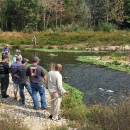Visit Us
Warm Spring National Fish Hatchery facilities include a public aquarium and displays which highlight the work done on station and by the Fish and Wildlife Service. Over 50,000 visitors annually get up close with our species and the conservation hatchery process. Educational opportunities for groups exist during visits to learn more about hatchery operations and resource issues.
Location and Contact Information
What We Do
The role of our hatchery is recovery of species that have become imperiled. Our mission is to remedy impacts of manmade dams that have altered a stream’s natural reproductive capability; to recover threatened or endangered populations; to restore inter-jurisdictional fish populations; to support depleted recreational fish populations in Federal and state waters.
Our Organization
Our Species
Species on station include:
- Alligator Gar
- Freshwater Mussels
- Gopher Frogs
- Gopher Tortoises
- Gulf Coast Striped Bass
- Hybrid Bass
- Lake Sturgeon
- Sicklefin Redhorse
Projects and Research
Warm Springs NFH produces fish, freshwater mussels, tortoises, and frogs for recovery programs within the state of Georgia and throughout the Southeast Region. Every year, the hatchery stocks thousands of fish in Georgia, Tennessee, North Carolina, and Florida. Gopher tortoises and gopher frogs are released every year across the state of Georgia.





